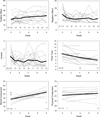Safety, tolerability, and clinical effect of low-dose buprenorphine for treatment-resistant depression in midlife and older adults
- PMID: 25191915
- PMCID: PMC4157317
- DOI: 10.4088/JCP.13m08725
Safety, tolerability, and clinical effect of low-dose buprenorphine for treatment-resistant depression in midlife and older adults
Abstract
Objective: To describe the clinical effect and safety of low-dose buprenorphine, a κ-opioid receptor antagonist, for treatment-resistant depression (TRD) in midlife and older adults.
Method: In an 8-week open-label study, buprenorphine was prescribed for 15 adults aged 50 years or older with TRD, diagnosed with the Structured Clinical Interview for DSM-IV, between June 2010 and June 2011. The titrated dose of buprenorphine ranged from 0.2-1.6 mg/d. We assessed clinical change in depression, anxiety, sleep, positive and negative affect, and quality of life. The Montgomery-Asberg Depression Rating scale (MADRS) served as the main outcome measure. Tolerability was assessed by documenting side effects and change in vital signs, weight, and cognitive function. Clinical response durability was assessed 8 weeks after discontinuation of buprenorphine.
Results: The mean dose of buprenorphine was 0.4 mg/d (mean maximum dose = 0.7 mg/d). The mean depression score (MADRS) at baseline was 27.0 (SD = 7.3) and at week 8 was 9.5 (SD = 9.5). A sharp decline in depression severity occurred during the first 3 weeks of exposure (mean change = -15.0 [SD = 7.9]). Depression-specific items measuring pessimism and sadness indicated improvement during exposure, supporting a true antidepressant effect. Treatment-emergent side effects (in particular, nausea and constipation) were not sustained, vital signs and weight remained stable, and executive function and learning improved from pretreatment to posttreatment.
Conclusion: Low-dose buprenorphine may be a novel-mechanism medication that provides a rapid and sustained improvement for older adults with TRD. Placebo-controlled trials of longer duration are required to assess efficacy, safety, and physiologic and psychological effects of extended exposure to this medication.
Trial registration: ClinicalTrials.gov identifier: NCT01071538.
© Copyright 2014 Physicians Postgraduate Press, Inc.
Figures


Similar articles
-
Evaluation of opioid modulation in major depressive disorder.Neuropsychopharmacology. 2015 May;40(6):1448-55. doi: 10.1038/npp.2014.330. Epub 2014 Dec 18. Neuropsychopharmacology. 2015. PMID: 25518754 Free PMC article. Clinical Trial.
-
Efficacy and safety of a monthly buprenorphine depot injection for opioid use disorder: a multicentre, randomised, double-blind, placebo-controlled, phase 3 trial.Lancet. 2019 Feb 23;393(10173):778-790. doi: 10.1016/S0140-6736(18)32259-1. Epub 2019 Feb 18. Lancet. 2019. PMID: 30792007 Clinical Trial.
-
Opioid Modulation With Buprenorphine/Samidorphan as Adjunctive Treatment for Inadequate Response to Antidepressants: A Randomized Double-Blind Placebo-Controlled Trial.Am J Psychiatry. 2016 May 1;173(5):499-508. doi: 10.1176/appi.ajp.2015.15070921. Epub 2016 Feb 12. Am J Psychiatry. 2016. PMID: 26869247 Clinical Trial.
-
A meta-analysis of the potential antidepressant effects of buprenorphine versus placebo as an adjunctive pharmacotherapy for treatment-resistant depression.J Affect Disord. 2020 Jun 15;271:91-99. doi: 10.1016/j.jad.2020.03.089. Epub 2020 Apr 17. J Affect Disord. 2020. PMID: 32479336 Review.
-
Pharmacodynamic and pharmacokinetic evaluation of buprenorphine + samidorphan for the treatment of major depressive disorder.Expert Opin Drug Metab Toxicol. 2018 Apr;14(4):475-482. doi: 10.1080/17425255.2018.1459564. Epub 2018 Apr 6. Expert Opin Drug Metab Toxicol. 2018. PMID: 29621905 Review.
Cited by
-
Buprenorphine/naloxone versus methadone opioid rotation in patients with prescription opioid use disorder and chronic pain: study protocol for a randomized controlled trial.Addict Sci Clin Pract. 2022 Sep 4;17(1):47. doi: 10.1186/s13722-022-00326-1. Addict Sci Clin Pract. 2022. PMID: 36057608 Free PMC article.
-
Patients on Buprenorphine Formulations Undergoing Surgery.Curr Pain Headache Rep. 2022 Jun;26(6):459-468. doi: 10.1007/s11916-022-01046-6. Epub 2022 Apr 23. Curr Pain Headache Rep. 2022. PMID: 35460492 Review.
-
Evaluation of opioid modulation in major depressive disorder.Neuropsychopharmacology. 2015 May;40(6):1448-55. doi: 10.1038/npp.2014.330. Epub 2014 Dec 18. Neuropsychopharmacology. 2015. PMID: 25518754 Free PMC article. Clinical Trial.
-
The Role of Dynorphin and the Kappa Opioid Receptor in Schizophrenia and Major Depressive Disorder: A Translational Approach.Handb Exp Pharmacol. 2022;271:525-546. doi: 10.1007/164_2020_396. Handb Exp Pharmacol. 2022. PMID: 33459877 Review.
-
Trends in Outpatient Buprenorphine Prescribing for Chronic Pain: A Retrospective Analysis Over 18 Months.Psychopharmacol Bull. 2025 Apr 8;55(3):8-19. Psychopharmacol Bull. 2025. PMID: 40223912
References
-
- Dew MA, Whyte EM, Lenze EJ, Houck PR, Mulsant BH, Pollock BG, et al. Recovery From Major Depression in Older Adults Receiving Augmentation of Antidepressant Pharmacotherapy. Am J Psychiatry. 2007;164(6):892–899. - PubMed
-
- Rush AJ, Trivedi M, Fava M. Depression, IV: STAR*D treatment trial for depression. American Journal of Psychiatry. 2003;160(2):237. - PubMed
-
- Thase M, Rush A. Treatment Resistant Depression. In: Bloom F, Kupfer D, editors. Psychopharmacology - 4th Generation of Progress. 4. New York: Lippincott, Williams, and Wilkins; 1995.
-
- Tao R, Auerbach SB. Opioid receptor subtypes differentially modulate serotonin efflux in the rat central nervous system. Journal of Pharmacology & Experimental Therapeutics. 2002 Nov;303(2):549–556. PubMed PMID: 12388635. - PubMed
-
- Hache G, Coudore F, Gardier A, Guiard B. Monoaminergic Antidepressants in the Relief of Pain: Potential Therapeutic Utility of Triple Reuptake Inhibitors (TRIs) Pharmaceuticals. 2011;4:285–342.
Publication types
MeSH terms
Substances
Associated data
Grants and funding
- P30 AG024827/AG/NIA NIH HHS/United States
- UL1 TR000005/TR/NCATS NIH HHS/United States
- R01 MH083660/MH/NIMH NIH HHS/United States
- AG033575/AG/NIA NIH HHS/United States
- KL2 RR024154/RR/NCRR NIH HHS/United States
- R01 AG033575/AG/NIA NIH HHS/United States
- P60 MD000207/MD/NIMHD NIH HHS/United States
- MH072947/MH/NIMH NIH HHS/United States
- MH083660/MH/NIMH NIH HHS/United States
- P30 MH090333/MH/NIMH NIH HHS/United States
- P30 MH090330/MH/NIMH NIH HHS/United States
- UL1 RR024153/RR/NCRR NIH HHS/United States
- R01 MH072947/MH/NIMH NIH HHS/United States
- KL2 TR000146/TR/NCATS NIH HHS/United States
LinkOut - more resources
Full Text Sources
Other Literature Sources
Medical

